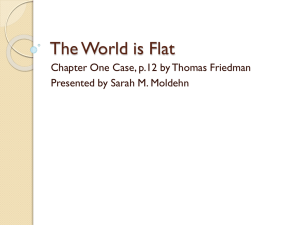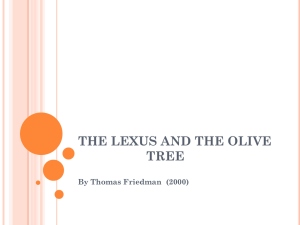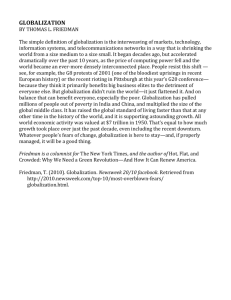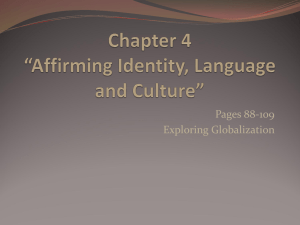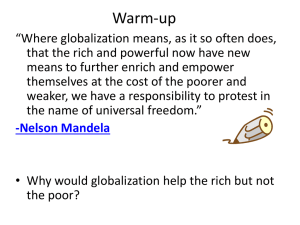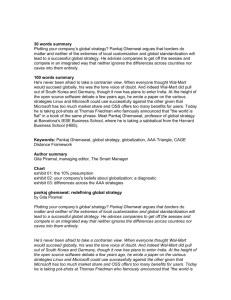Wiggins Matthew Wiggins Dr. Robert Farkasch IRLS 504
advertisement
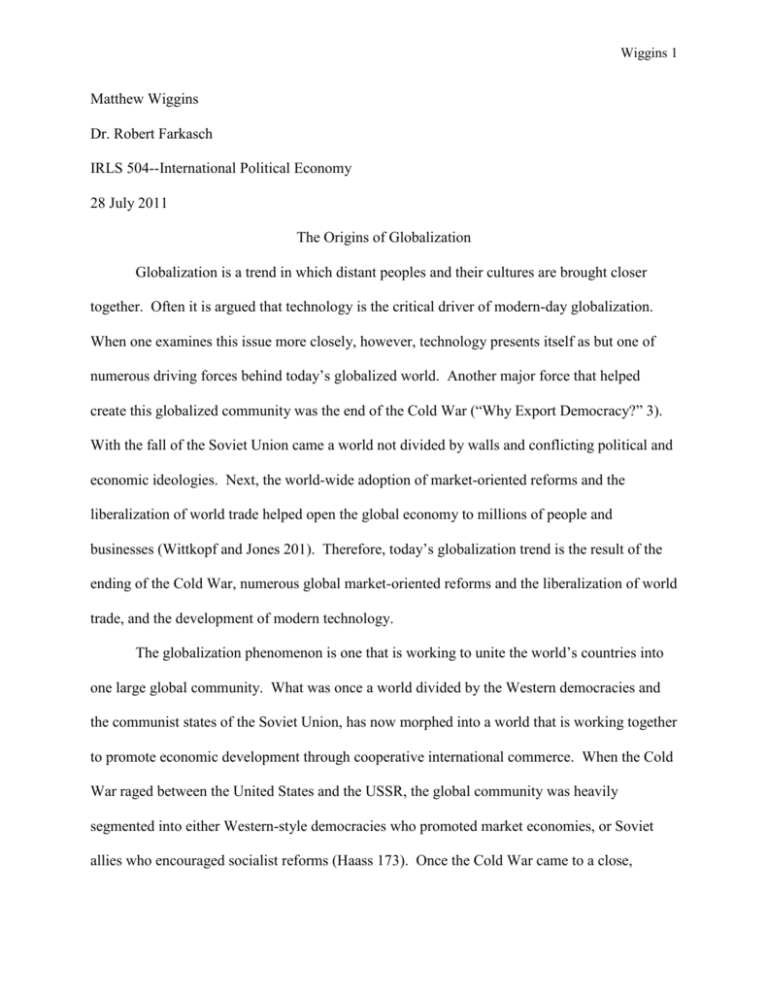
Wiggins 1 Matthew Wiggins Dr. Robert Farkasch IRLS 504--International Political Economy 28 July 2011 The Origins of Globalization Globalization is a trend in which distant peoples and their cultures are brought closer together. Often it is argued that technology is the critical driver of modern-day globalization. When one examines this issue more closely, however, technology presents itself as but one of numerous driving forces behind today’s globalized world. Another major force that helped create this globalized community was the end of the Cold War (“Why Export Democracy?” 3). With the fall of the Soviet Union came a world not divided by walls and conflicting political and economic ideologies. Next, the world-wide adoption of market-oriented reforms and the liberalization of world trade helped open the global economy to millions of people and businesses (Wittkopf and Jones 201). Therefore, today’s globalization trend is the result of the ending of the Cold War, numerous global market-oriented reforms and the liberalization of world trade, and the development of modern technology. The globalization phenomenon is one that is working to unite the world’s countries into one large global community. What was once a world divided by the Western democracies and the communist states of the Soviet Union, has now morphed into a world that is working together to promote economic development through cooperative international commerce. When the Cold War raged between the United States and the USSR, the global community was heavily segmented into either Western-style democracies who promoted market economies, or Soviet allies who encouraged socialist reforms (Haass 173). Once the Cold War came to a close, Wiggins 2 however, with the fall of the Soviet Union in 1991, a newfound world peace settled across the globe. World peace helped stimulate the world economy by making international commerce possible (Ghemawat 34). Thus, when the countries of the former Soviet Union gained their independence many of them adopted market economic reforms. Another stimulant of today’s globalized world is the result of countries across the globe adopting free-market economic reforms that led to the liberalization of world trade beginning in the 1990s. Some three billion people who were out of the game walked, and often ran, onto the playing field (“Why Export Democracy” 3). These were the people of China, India, Russia, Eastern Europe, Latin America and Central Asia. Their economies and political systems all opened up during the course of the 1990s so that their people were increasingly free to join the free market (Friedman 78). Now that non-Western peoples had the ability to participate in a market economy, they could engage in as much international commerce as possible. Furthermore, tariffs on goods have declined from a worldwide average of over 25% in 1980 to less than ten percent today (Mattoo and Subramanian 16). This free-market commerce on a global scale, however, was made most possible by modern technologies such as the home computer and the Internet. Lastly, when militaries of the major world powers (U.S.) made it possible for the public to access the most-developed telecommunications network the world had ever seen, along with the invention of the personal computer, people from distant parts of the world were brought together easier and faster than ever. As a result of modern technology, goods and services can be exchanged over long distances in little time virtually for free (Ghemawat 3). It is technology that is allowing the Global South to better compete with the Global North in the world economic market. The people of India, for example, are able to tap into the Western service market as a Wiggins 3 result of advanced telecommunications. Not only has the United States outsourced blue-collar manufacturing jobs, but due to modern technology, people in India can offer accounting, medical, and education services from across the world (Friedman 54). People in other parts of the developing world are benefitting from technology in a similar way in that technology is giving them the window through which to communicate and interact with the outside world for free. In sum, what the Netscape revolution did was bring people-to-people connectivity to a whole new level. Suddenly more people could connect with more other people from more different places in more different ways than ever before (Friedman 4). The Internet has had a flattening effect on the world in that now people in the developing world are better able to compete in the world economic market (Wittkopf and Jones 197). Therefore, the advent of modern technologies and public access to global telecommunication networks made the Internet possible, and with it, global communication and commerce. In conclusion, today’s globalization trend is the result of the ending of the Cold War, numerous global market-oriented reforms, and the development of modern technology. What was once a world divided by the Western democracies and the communist states of the Soviet Union, has now morphed into a world that is working together to promote economic development through cooperative international commerce. With the ending of the Cold War, most countries today are pursuing market economies that are looking to grow through international, many times multilateral, trade agreements. Lastly, the development of modern technologies has given people the ability to communicate and conduct business on a global level as never before seen. The globalization phenomenon is one that is working to unite the world’s countries into one large global economic community. Wiggins 4 Works Cited Friedman, Thomas L. The World is Flat: A Brief History of the Twenty-First Century. New York: Farrar, Straus and Giroux, 2006. Print. Ghemawat, Pankaj. “Why the World Isn’t Flat.” Foreign Policy March 2007: 34-36. Print. Haass, Richard. “Getting 21st Century U.S. Foreign Policy Right.” The Globalist (2005): 173-175. EBSCO. Web. 23 August 2011. Mattoo, Aaditya, and Arvind Subramanian. “From Doha to the Next Bretton Woods: A New Multilateral Trade Agenda.” Foreign Affairs November 2008: 16. Print “Why Export Democracy?: The ‘Hidden Grand Strategy’ of American Foreign Policy.” The Wilson Quarterly 23.2 (1999): 3. Gale. Web. 21 August 2011. Wittkopf, Eugene, and Chrisopher Jones. American Foreign Policy: Pattern and Process. Boston: Thomson Higher Education, 2008. Print.

